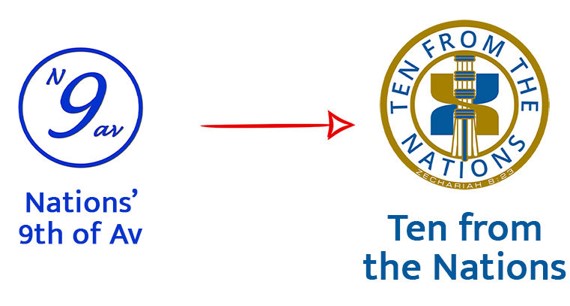My first Sukkot was in Upper Michigan at my friend Rhonda’s house. We were new in the walk and really didn’t know how to celebrate it, other than what the Torah stated in Leviticus 23 and Deuteronomy 16. This was in 1997. We didn’t know any Jewish people in our very small town to ask what to do. We had been listening to a teaching series by Zola Levitt called “Discovering Our Jewish Roots” on cassette tape. We learned about Sukkot and desired to “keep” the Feast as best as we could where we lived.
It was fall and the ground was covered with leaves. The air was crisp, and we talked about how to build a sukkah. We didn’t really know what it was supposed to look like, so we improvised. Rhonda had a wooden “jungle gym” in her front yard. We collected branches from the trees in her yard and any green foliage we could find and decorated the jungle gym with them. We put a blanket under the jungle gym and had a meal together on the first and 8th day. It was simple and I believed YHVH was honored and blessed.
The following year we contacted the local Reform Synagogue in our area and learned that they built a temporary structure usually adjacent to the local synagogue. In 1998 I had the pleasure of going to Israel at the end of Sukkot and saw all the sukkahs on apartment balconies and outside of homes. There was a very large sukkah in the courtyard of the Western Wall. This was exciting for me to see.
The following year, our little Bible study home group built a sukkah in the woods next to one of the fellowship group members camp near a lake. There were lots of trees, so we took rope and wrapped it around several of them, left an opening and then laid branches on the rope mesh to create a wall. We put blankets on the leaves on the ground and had our 1st and 8th day gatherings there. We ate a meal and studied together in our outdoor sukkah.
I moved to Spokane in 2000 and celebrated Sukkot with a local Messianic congregation. The sukkah was built on the property of the Rabbi. We all gathered at their home for the 1st and 8th day celebration.
For the next 7 years I either built a sukkah in my living room (if the weather was bad) or adjacent to my house. I had a deck off the kitchen and a large tree that hung over. I used PVC pipe to create a frame and sheets from the local thrift store to create the walls. The tree that overhung the deck was the top covering. I put a table, chair, stationary hammock, and outdoor rugs in my sukkah. I had a meal in it every day, read my Bible, and invited others to join me.
I moved to Seattle in 2008 and found out about another “tradition”. The group I fellowshipped with did “Sukkah Hopping”! Those who built a sukkah in their yard would invite people over each night of Sukkot to either share a meal or dessert and have fellowship. It was fun to travel to different locations and see different sukkahs and how people decorated them.
When I moved to South Carolina in 2011, I learned of another “tradition”. People camped at a campground together for the 8 days of Sukkot! This was all very new to me as we never considered camping for Sukkot “up north” because it could be very cold (or even snow) during that time of year. I really liked this new tradition and enjoyed the opportunity to spend time with those I was in community with. The group built a community sukkah, and some built them on their individual campsite. It was fun to go from campsite to campsite and have fellowship in their sukkah.
This year, my husband and I have decided to build a sukkah in our backyard and revisit the Sukkah Hopping tradition for those who are not camping this year. We will join the campers at the campground for Shabbat and the Holy Days.
What is the purpose of the Feast of Sukkot?
Leviticus 23:42-43 “You are to live in sukkot for seven days; every citizen of Israel is to live in a sukkah, so that generation after generation of you will know that I made the people of Israel live in sukkot when I brought them out of the land of Egypt; I am YHVH your Elohim.”
The children of Israel did not have a permanent home when they left Egypt. They lived in “temporary dwellings” while traveling through the desert to the Promised Land. YHVH provided for the needs of the children of Israel during that time. While we are in these earthly bodies we also live in a temporary dwelling. YHVH provides for all our needs as well. We celebrate Sukkot now to remember what it was and is like to live in a temporary dwelling and remember how He provides for our needs.
There is no “right” way to keep the Feast of Sukkot in the diaspora. As you can see from my story, I’ve celebrated Sukkot many ways, by myself and with others. I believe YHVH was blessed by my attempt to honor Him to the best of my ability.
What do I do if I don’t have a fellowship or congregation to meet with?
If you are someone who doesn’t have a home group or congregation to keep the Feast with, you can still build some kind of temporary structure and “live” in it for 7 days. It is ideal to have it outside, but I knew someone who put a tent in their living room because of the weather. Their goal was to have a set apart place to spend set apart time with YHVH. Be creative! Ask YHVH how you can honor Him. Spend quality time with YHVH during those days and draw near to Him. Do the best you can, and He will honor you for your efforts.
Whatever way you choose to celebrate the Feast of Sukkot this year, may YHVH reveal Himself to you in a greater way as you spend time with Him.
Dorothy Wilson







